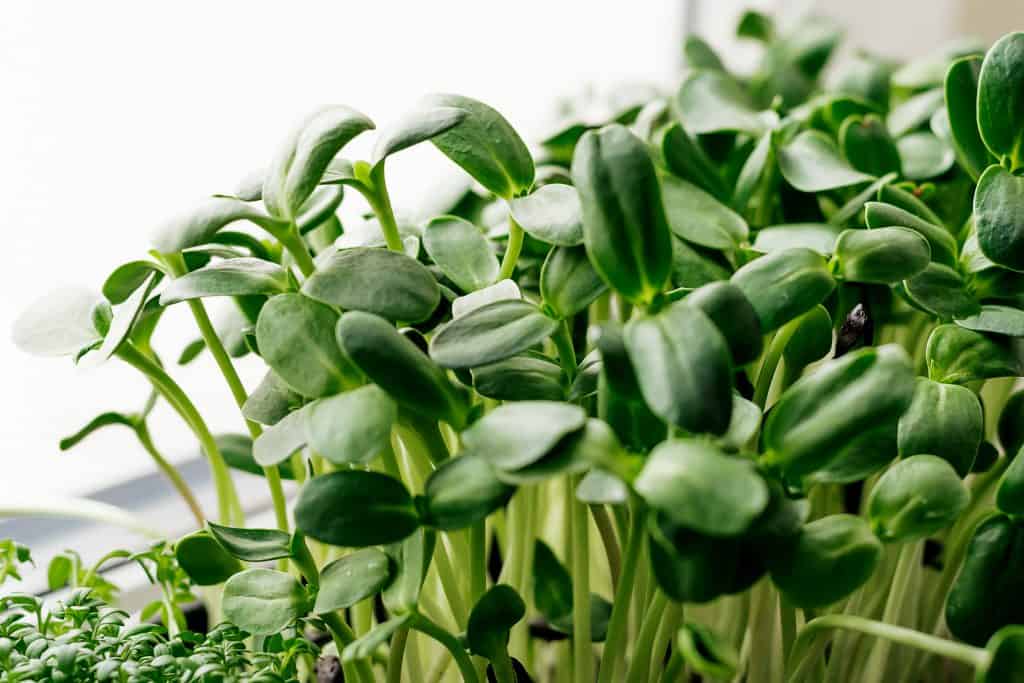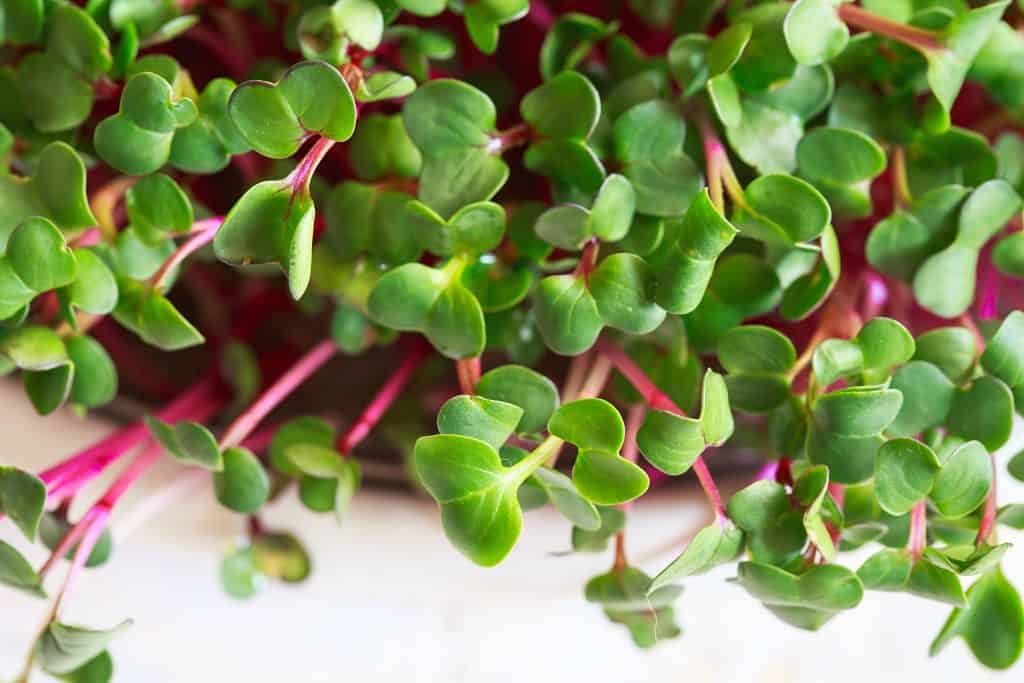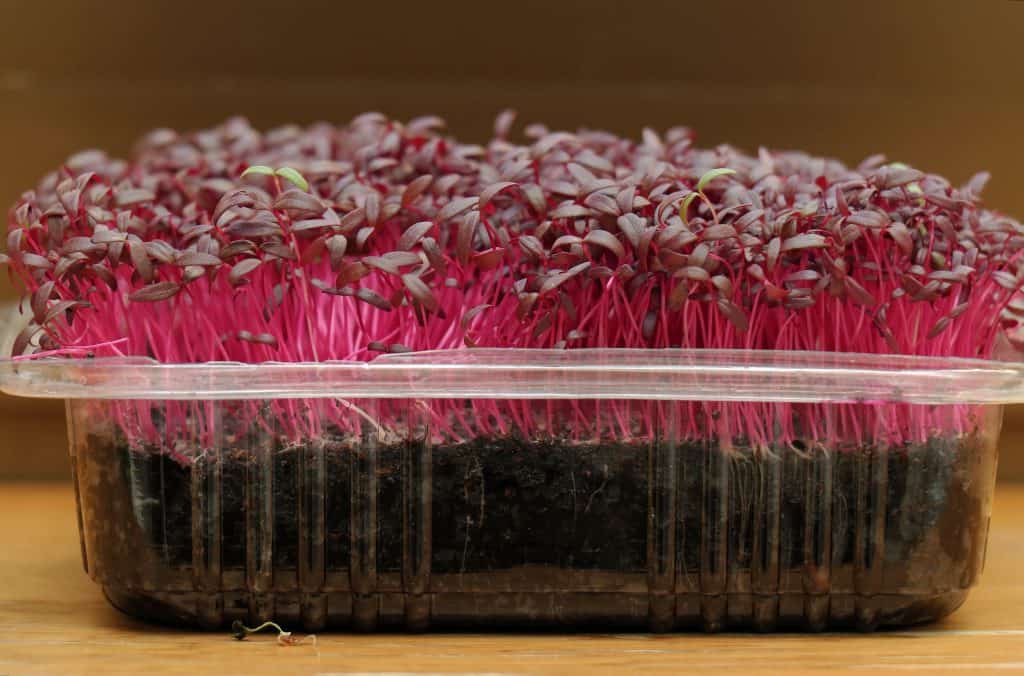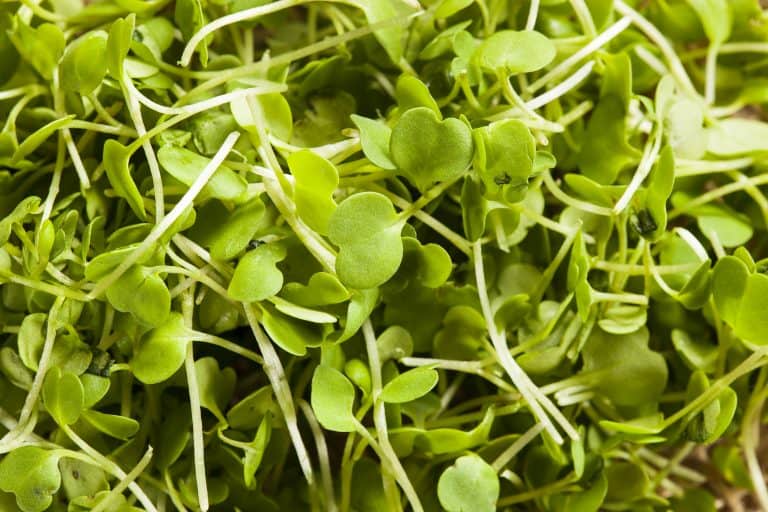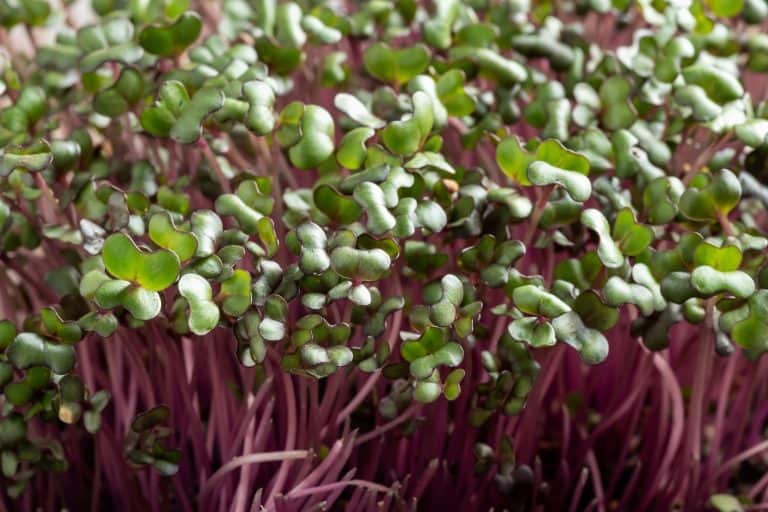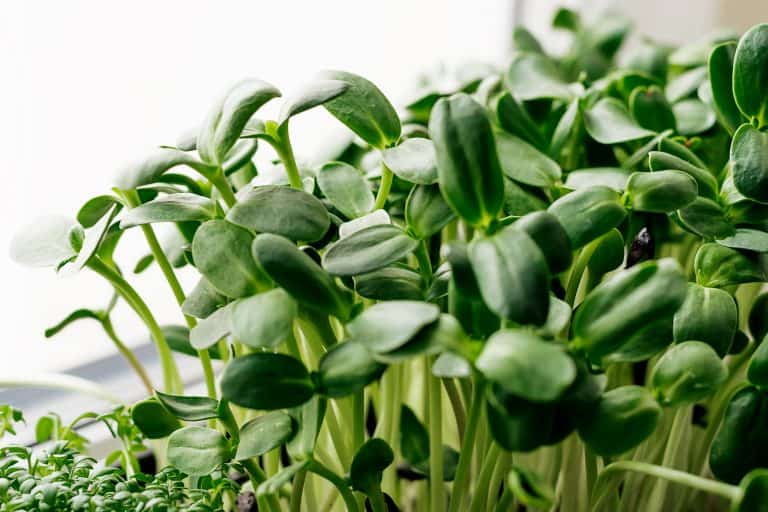Broccoli Microgreens Ultimate Growing Guide
Disclosure: This post may contain affiliate links, meaning I get a commission if you decide to make a purchase through my links, at no cost to you.
Want a food that packs an amazing nutritional punch with a much milder taste than full grown broccoli? You have got to try broccoli microgreens!
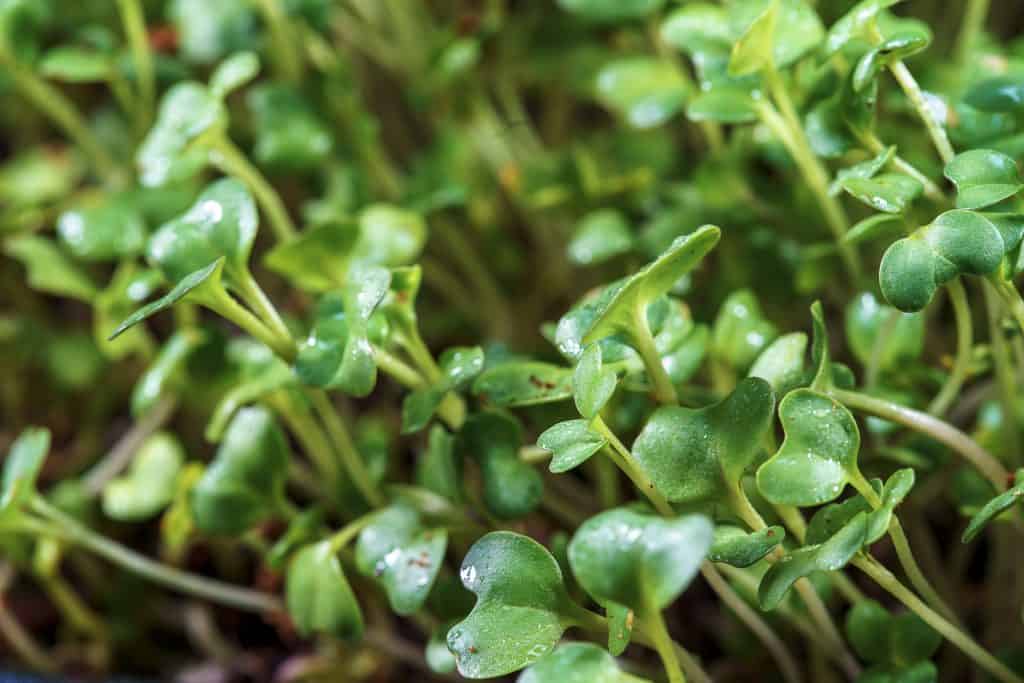
Out of all the microgreens I’ve tried, these are by far one of the easiest varieties to grow. They are delicious raw or cooked and are amazingly versatile. Plus, they are soooo good for you!
If you have any picky eaters in your house that aren’t big fans of broccoli, or if you just don’t like the smell of full-grown broccoli heads after they cooked, you have got to try broccoli microgreens! The same (or better!) nutrition in a tiny little package.
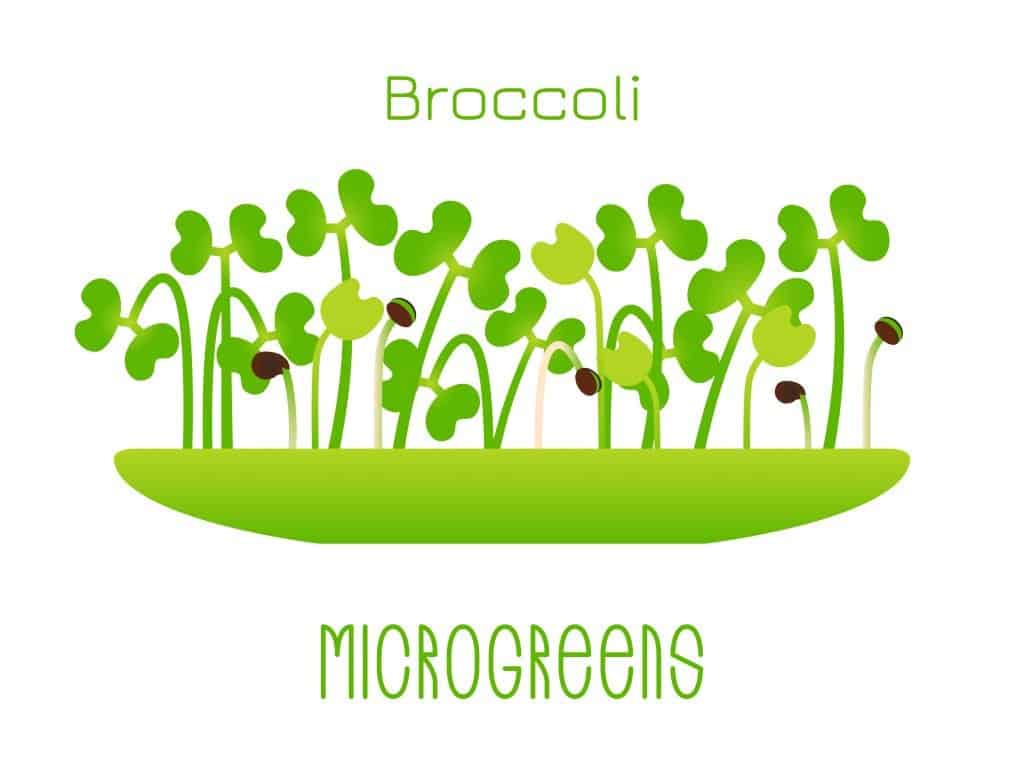
Broccoli Microgreens Profile
Flavor: Mild broccoli flavor, slightly bitter or earthy
Texture: Crunchy
Presoak: None
Soak: None
Rinse/Drain: None
Germination: 2-4 Days
Harvest: 7-14 Days
Difficulty Level: Beginner
Broccoli Microgreens Nutrient Profile
Serving Size: 1/2 cup
Calories: 10
Fat: 0g
Cholesterol: 0mg
Carbohydrates: 1g
Protein: 1g
Each serving also is also high in nutritional value of Vitamins A, B group, C, E and K as well as minerals such as magnesium, calcium, iron, phosphorus, copper and zinc.
This vegetable is also an amazing source of sulforaphane, which has been shown to help with health problems like heart disease, cancer and type 2 diabetes!
And these little guys have more nutrition than mature broccoli, so move over full-grown broccoli plant, make way for microgreens!
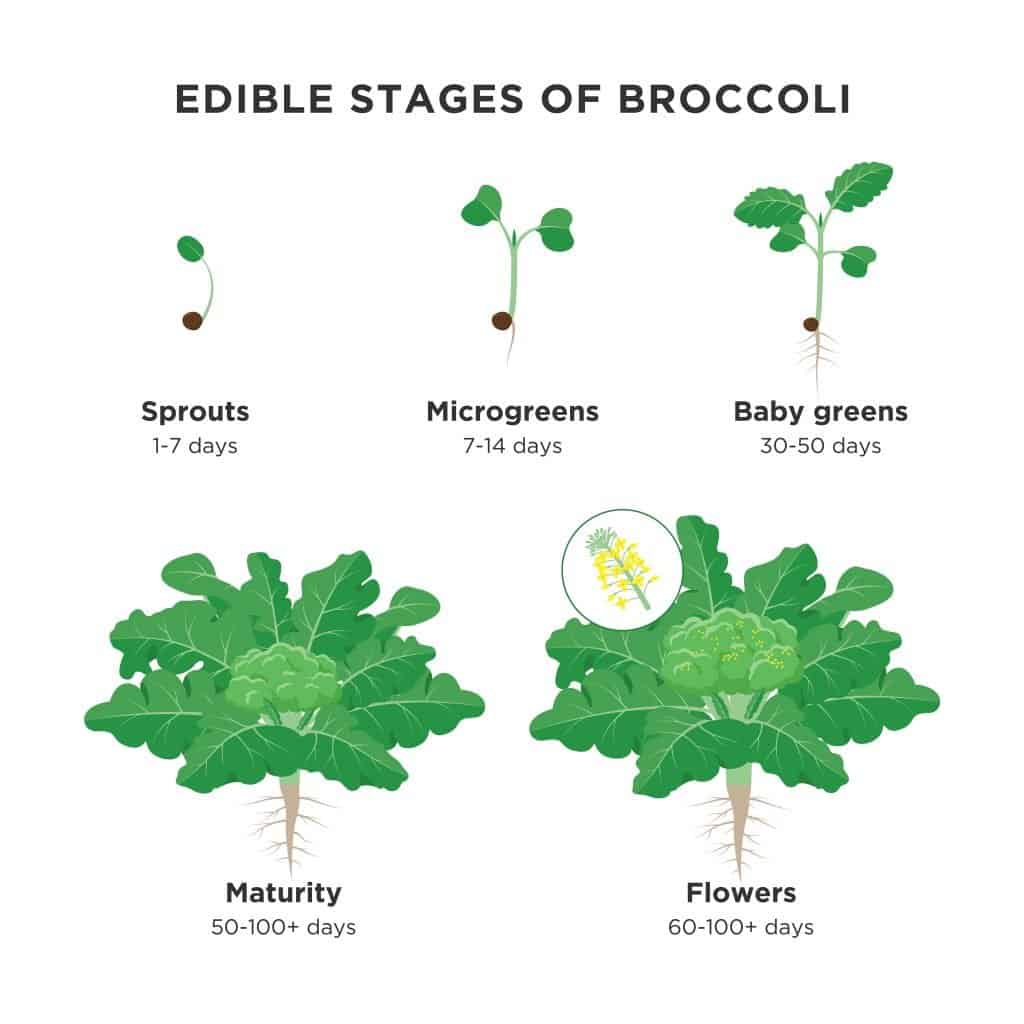
Tips and Tricks for Growing Perfect Broccoli Microgreens
Note that this is different than growing broccoli sprouts. Sprouts are grown without soil and eaten seed and all. Microgreens are allowed to grow their first leaves before being consumed.
1. Pick the right soil. Choosing regular garden soil can leave you open to pests and isn’t the optimal growing medium for microgreens. We will talk more about what makes great soil below. If you prefer not to have messy soil inside, broccoli microgreens are easy to grow on jute mats, too!
2. Once the seeds sprout, you need to water the broccoli from the bottom to prevent mold. A lot of microgreens can be sprayed with water, but you will want to avoid that with broccoli.
3. If you notice tiny white hairs on your growing sprouts, don’t fret – these are the roots! They do look a little like mold, but let them grow and you will see they are a tiny, hair-like root structure.
4. Don’t be fooled – these little guys may not look like full-grown broccoli, but they are just as nutritious, maybe even more!
Growing Broccoli Microgreens (Step by Step)
Supplies You Need to Grow Broccoli Greens
Seeds
Seeds are the first thing you will need to grow your micro greens. Without them, you won’t be able to grow anything!
You can use just about any seeds that haven’t been heated, but I would stay away from ones that weren’t meant for human consumption.
The best type of seeds to buy for growing broccoli greens are seeds such as the Waltham 29 or other organic broccoli seeds. There are also varieties that specifically say they are microgreen seed.
Where to buy broccoli microgreen seeds:
Container
You will need some type of container for growing your seeds in. If you want to sprout your seeds, you won’t need any soil and the container will be different. Since we are growing microgreens, we will need a bit more.
The right container for this type of seed is a shallow one, only 1 to 2 inches deep. The greens will be harvested before they get very large, so you don’t need anything more than this.
There are a million different containers that are shallow like this, and all can work as long as there is ample drainage. If you don’t allow drainage you will find that the water just pools in the container and can rot the roots, so be sure to choose a container that can drain.
You also need to ensure that your container is durable and food-safe, so be sure not to use pressure treated wood or another material that could make the greens unsafe to eat.
You can recycle old milk cartons or jugs by cutting them down, or buy fancy new trays made for microgreens. Make it yourself for free or spend a lot – it’s up to you!
Remember that this type of broccoli microgreen needs to be watered from the bottom, so it might be good to invest in a system that has holes in the growing container and then a separate watering tray.
If you want to buy some durable, safe containers, here are my recommendations:
Soil
The right soil is the next key to growing great microgreens. If you’re growing some greens outdoors, pretty much any soil will do. But most people grow microgreens indoors, which is a big part of the appeal of these mini greens.
You want the soil you choose to have great nutrients for your baby greens. Indoor potting soil is going to be the best choice for this. This is because they are safe to use indoors (no fungus, bugs, or molds!), they allow for ample drainage but still retain moisture for baby roots, and they allow for air pockets in the soil. Choose organic soil if possible.
You can also grow broccoli microgreens in coconut coir. This growing medium is made from – you guessed it! – coconut! Specifically the husk of the coconut fruit. Coconut coir retains moisture. is resistant to microbial breakdown and is easier to wet than peat moss.
Recommended Soils for Microgreens:
Soaking
Soaking the seeds is an important step in certain types of microgreens, such as sunflower microgreens, but for broccoli you can skip this step!!
You’re ready to plant!
Planting
Growing broccoli microgreens is very easy.
First, you will want to fill your soil almost to the top of the growing tray. It doesn’t really matter what type of soil you are using as mentioned above. Just ensure that it’s clean and made for using indoors (preferably).
Then, you will want to add your seeds. You want to completely cover the top of your soil with seeds, making sure there aren’t any stacked on top of each other.
You really don’t need to cover your seeds, so you can leave them on the soil surface, but I’ve seen various recommendations for this and they all work well. The seeds do need dark to germinate, so place them somewhere dark for a couple of days.
I know, it seems weird to put the plants out of the sunlight since you want them to grow, but plants actually need dark to germinate. Think about it, they are usually deep in the ground, not in direct sunlight when they are planted.
Many sources actually recommend putting them in the dark for a period of time before bringing them out into the sun. Try both methods and see what works best for you!
Once the seedlings emerge they will need light. All seedlings need sunlight (or a grow light) on those new baby green leaves to grow, so make sure to move them into the sun or a grow light after they break the surface of the soil.
Growing/Watering
You want to keep the soil in the container slightly damp, but not soggy. Remember to water from the bottom once they have sprouted!
Make sure that the seedlings get access to fresh air once they are sprouting leaves. I tried growing lavender one time and just left the lid on the mini greenhouse all the time and it did not go well for me. While they need some humidity, too much can make the stems rot, which is what I found with my lavender plants. (I’ve learned a LOT since then!) So if you do use a container with a clear lid (whether you buy a mini greenhouse or make one), make sure to take it off once the seedlings start to grow.
Be sure not to overwater. This is another early mistake I made! You only want to water enough for the soil to be damp, not wet. You can rot your plants this way (yep, been there) and can also grow fungus on the plants.
Harvesting
The ideal harvest time is 7-14 days after planting.
You want your sprouting broccoli seeds to have developed two big leaves (the cotyledon), known as seed leaves, before the true leaves appear. If you wait until they get that true leaf pair in the middle you will find a much different taste, which I personally don’t like, so be sure to harvest them before then.
We really love these fresh microgreens in our house and the kids can’t wait for them to get very large, so we usually don’t have a problem eating them in time.
To harvest, use a small, sharp pair of scissors to cut the seedlings off at the base (you don’t want any soil, so cut just above the soil line). Then you will want to wash the greens. Some people like a salad spinner for this, but we just lay them gently on a towel or paper towel and then use a second towel or paper towel to gently pat dry. Sometimes the kids will sneak them before washing!
Harvest as many as you want to use and leave the rest to harvest later. I find that this works better than harvesting them all at once and storing them in the fridge.
Storing
While these are best eaten directly after harvest, you can store them in a ziptop bag in the refrigerator. If you grow more than one type of green, I recommend labeling your bag with the type and date of harvest.
Try not to water the greens 12 hours before harvest if you are going to store them, and don’t wash them until you are ready to use them. Moisture is their enemy when storing, so keep them as dry as possible.
Preferably, you will want to gently fold them in a paper towel and then place in a ziptop bag. Use within 3-4 days for best results.
Once cut, a broccoli sprout will not regrow, so you will need to compost the soil that the roots are left in. Some people reuse the soil, but I have not had much success with this. Since so little soil is used anyway, it makes sense to just compost and start with new.

Can you Grow Broccoli Microgreens Without Soil?
This is a very common question and the answer is YES!
To grow these greens without soil, you will need the same supplies as above, but without the soil. Instead, you will need a jute or hemp mat.
If using a jute mat, place it in your growing container and place the seeds on top of it. Keep it moist and the seeds will put down roots into the mat.
Water from the bottom as above and harvest at the same time as the soil-grown counterparts.
How to Eat Broccoli Microgreens
These amazing little fresh greens can be added to almost anything. They have the texture of spinach with a mild broccoli taste.
You can eat these greens raw or cooked, but if cooking try to add them at the end to retain their nutrient value and their delicate crunch.
I love to add mine to pizza, sandwiches, omelettes, soups and salads. I also blend mine into smoothies, sneak them into dips and a lot of other special sneaky recipes I’ll be sharing soon!
The kids even like to snip and eat them straight from the growing tray!
Common Problems Growing Microgreens
We are going to assume that you are growing your greens indoors and address some common problems you might encounter when growing broccoli microgreens.
1. Mold, Mildew or Fungus
This is by far the most common problem with growing microgreens. Remember not to mistake the white root hairs for mold!
Too much moisture is one of the main culprits when it comes to mold, mildew or fungus. These types of things love soggy conditions, so be sure not to overwater and get soggy soil. Be sure to allow ample drainage so this doesn’t happen.
You can also get too much moisture by having your humidity too high. This is what happened to me when I didn’t take the top off of the greenhouse (okay, one of the things!). It also allowed for too much moisture and caused my plants to rot.
Mold, mildew or fungus can also happen to broccoli microgreens when sprayed or misted with water. Remember to only water from the bottom once the leaves begin to appear.
2. Yellow, “Leggy” Stems
This is a problem I used to have with all of my seedlings and it took me a long time for me to figure out why it was happening!
Most microgreens will be yellow in appearance when they first emerge from their seeds, but once the young plants get some light they should turn green.
If you find that your seedlings are staying yellow and they are getting tall and “leggy”, the problem usually is that they are not getting enough sun.
When this happened to us we were growing our seedlings in a small lean-to shed that we had turned into a greenhouse with clear panels on the ceiling. Unfortunately this wasn’t giving them the light they needed.
They will need strong, direct light, so place them in a windowsill or other area with good lighting, or get a grow light. We’ve picked up the bulbs pretty inexpensively and they work well. Just remember to turn them off at night so they plants get some darkness!
Some people have found that broccoli microgreens do better under a nice grow light or even a fluorescent light, so experiment and see what does best for you.
3. Seeds are Slow to Germinate
It’s so disappointing to check on your greens expecting to see growth and find that nothing is happening. I’ve been there! However, there are a few things you can do to help in this situation.
First, ensure that you did not flood your seeds. Leaving them in a soupy soil can rot them before they’ve even had a chance to sprout, so ensure that the soil is moist, but never wet.
You can use a seed mat to speed up the germination process. It helps warm up the soil to encourage the seeds to sprout.
Finally, make sure you bought quality seeds. Seeds from different companies will have different germination and growth rates, so be careful when picking out your seeds.
4. Plants are falling over.
If you see that your plants are falling over and lying on their sides, that’s usually a sign of underwatering. Give your plants a good watering and they should perk back up.
Common Questions about Broccoli Microgreens
Absolutely yes – and you should! These little guys are nutritional power houses and should be added to a healthy diet. You can use them in place of lettuce in salads, on sandwiches and in soups. You can also blend them into smoothies or add them to juices for added health benefits.
No. Growing microgreens is different than growing broccoli sprouts. Sprouts are grown without soil and eaten seed and all. Microgreens are allowed to grow their first leaves before being consumed.
No, these mini greens do not regrow after cutting. You will need to start a new tray to get another harvest.
Yes! The microgreens have more nutrients than the mature vegetable. Studies have proven that microgreens can contain up to 40 times the amount of nutrients than their mature counterparts.
What are the Benefits of Broccoli Microgreens?
Broccoli microgreens are high in Vitamins A, B group, C, E and K as well as minerals such as magnesium, calcium, iron, phosphorus, copper and zinc.
This vegetable is also an amazing source of sulforaphane, which has been shown to help with health problems like heart disease, cancer and type 2 diabetes!
And these little guys have more nutrition than mature broccoli, so move over full-grown broccoli plant, make way for microgreens!
